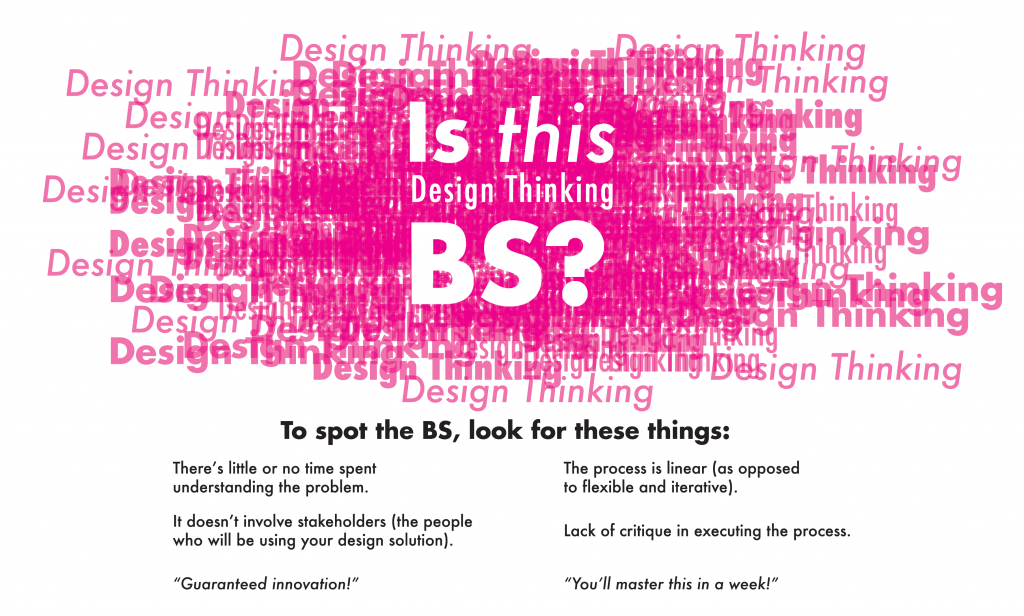I’ve been on an emotional rollercoaster following my first read of an article, Design Thinking is B.S. by Natasha Jen (and watching the connected video). A gut reaction to protect my discipline (“You’re wrong!”) was quickly followed by feeling deeply offended that an educated, highly capable woman could be so wrong about my discipline (“I think she only did a google search for her research!!”). These initial reactions lead me to talk to many people in and closely related to my field.
What I’ve found is, well, sometimes Design Thinking is BS. The issue is that people are using it in different ways right now. The term’s meaning is in transition.
Words change meaning all the time. The word nice used to mean “silly, foolish, and simple.” Naughty went through several changes: initially, to be naughty meant you had naught or nothing. Then it came to mean evil or immoral, and now you are just badly behaved. (TED Guest Author, 2014). This metamorphosis of word meaning happens all the time. Here’s a list of 20 words that once meant something very different. The trouble with this natural phenomenon of language occurs during the transition, when individuals use the same word to mean different things without realizing it. Sometimes we forget to confirm that we mean ‘lit’ as in cool, not ‘lit’ like on fire.
This summer, I attended the AIGA Design Educators Conference: MAKE and talked with many designers about Design Thinking and how the term is in transition. Until recently, I have been defining Design Thinking as: a human-centered process to learning and discovering the roots of a problem, transforming those into opportunities while working with stakeholders to create solutions. This is what I do and what many people who call themselves design thinkers are doing using a very purposeful and thorough process with significant results. Here’s an example.
Many of the conference go-ers I spoke with used the term referencing the new, corporate ‘go to,’ cookie-cutter process that’s being sold. This was the final nail in the coffin for me to have a clear understanding of this term’s new meaning. It’s become a corporate buzzword that refers to a watered down, easy to digest process that gets you and the people you’re working with to ‘innovate’ and ‘think in a different way’ and ‘design the next iPhone’ or something. The term is in a transition. It stems from what we do but it’s just a bland taste of it, an introduction at best, and it’s often presented as an over-promise.
The way that it’s presented is how Design Thinking is sometimes BS. Often you will see a boot camp, workshop, or webinar that is ready to teach you Design Thinking. Look closely at what the company is selling. Are you getting the watered-down “corporate package” or are you getting into the real deal? To spot the BS, look for these things:
- “You’ll master this” in a week!
- It’s linear (as opposed to flexible and iterative).
- “Guaranteed innovation!”
- Lack of critique in executing the process.
- It doesn’t involve stakeholders (the people who will be using your design solution).
- There’s little or no time spent understanding the problem.

We (the designers at Research Jam) always appreciate that more and more people are learning these skills. It seems like the impetus for the article Design thinking is BS is the trend of companies selling the idea that someone can take a boot camp/workshop/webinar and walk away from it being a seasoned professional designer. I agree with this reaction because that sort of outcome is un-realistic. And I think (hope) those putting on the workshops would agree too. It takes years to master these skills. I would urge anyone putting on these types of workshops to understand what Design Thinking really is and to be careful to frame your workshops honestly.
Now that I’ve had time to process who is using this term and how it’s being used, it doesn’t upset me. I’m not psyched about the change; it would be easier for me if the language in my field didn’t change. But that’s not the way things work. Terms take on meaning based on how they’re used in the world, not how I personally use them. It doesn’t change the fact that I’m a People-Centered Design Researcher and the iterative process that I use has similar words to what the world now calls “Design Thinking.”
The leaving thought is this: if you are interested in learning more about Design Thinking, awesome! Check out these books to get started: Design Thinking: Understanding How Designers Think and Work by Nigel Cross (this one is about the overall process) and Design Thinking: Integrating Innovation, Customer Experience, and Brand Value edited by Thomas Lockwood (this one is a compilation of case studies showing examples of design thinking in use). That way, you’ll be able to better critique any Design Thinking workshops/seminars/boot camps you’re presented with and have realistic expectations of what you will be able to do with what you learn there. Look for the meaning behind the term. How are they using it? What’s their definition? Because, sometimes ‘Design Thinking’ is BS.
